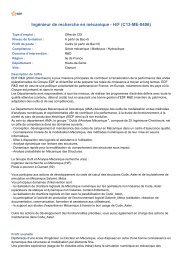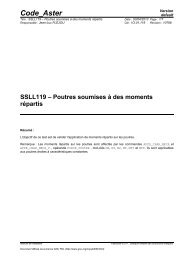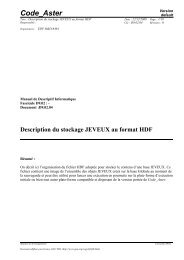U1.03.01 - Code_Aster
U1.03.01 - Code_Aster
U1.03.01 - Code_Aster
You also want an ePaper? Increase the reach of your titles
YUMPU automatically turns print PDFs into web optimized ePapers that Google loves.
<strong>Code</strong>_<strong>Aster</strong><br />
Titre : Superviseur et langage de commande<br />
Version<br />
default<br />
Date : 08/05/2012 Page : 10/16<br />
Responsable : Christophe DURAND Clé : <strong>U1.03.01</strong> Révision : 8998<br />
the representation of the complex type are a “tuple” python containing a character string indicating the<br />
mode of representation of the complex number (left real and imaginary or modulus-phase) then the<br />
digital assets.<br />
Catalogue : VALE_C= SIMP (statut='F' , typ = ` It),<br />
Fichier of commands : VALE_C= (` IH' , 0,732, -0,732),<br />
Command file : VALE_C= (` MP' , 1. , -45. ) ,<br />
the two notations are strictly equivalent. In notation ` MP', the phase is in degrees.<br />
The standard text is declared between simple dimensions. Breakage is respected. However, when a<br />
key word must take a value in a preset list in the catalogue, the use wants that this value is today<br />
always in capitals.<br />
Catalogue : TOUT=SIMP (typ= ` TXM', into= (` OUI','NON'))<br />
,<br />
Command file : TOUT= ` OUI' ,<br />
Breakage is important and, in the context above, the following command line will fail:<br />
Command file : TOUT= ` yes' ,<br />
The logical type is not used today in the catalogue of commands.<br />
The concept is declared simply by its name, without dimensions nor quote marks.<br />
3.5.3.2 Concept of Attention<br />
list :<br />
The word “list” is an abuse language here. It is not the type “lists” python but rather of tuples, within the<br />
meaning of python: different the items is declared between an opening bracket and a closing bracket;<br />
they are separated by commas.<br />
The lists are homogeneous lists, i.e. whose elements are of the same basic type. Any basic type can<br />
be used in list.<br />
Examples of list:<br />
list integers (1, 2,3,4),<br />
list of text (“this”, “is”, “one”, “list”, “of”, “text”),<br />
list of concepts (resu1, resu2, resu3),<br />
User friendliness:<br />
It is allowed that a list reduced to an element can be described without bracket.<br />
Example of erroneous list:<br />
Heterogeneous list of integer and reality<br />
(1, 3.4.)<br />
3.5.4 Key word factor<br />
Certaines information cannot be given overall (in once in the command), it is thus important to<br />
envisage the repetition of certain key words, to be able to affect different arguments to them. The key<br />
word factor offers this possibility; under a key word factor, one will thus find a set of key words<br />
(simple), which could be used with each occurrence of the key word factor. That makes it possible<br />
moreover to improve the legibility of the command file by gathering key words which share a common<br />
meaning: for example various parameters of the same material.<br />
Warning : The translation process used on this website is a "Machine Translation". It may be imprecise and inaccurate in whole or in part and is<br />
provided as a convenience.<br />
Licensed under the terms of the GNU FDL (http://www.gnu.org/copyleft/fdl.html)




![[V5.02.132] SDNL132 - Pendule rigide avec contacts ... - Code_Aster](https://img.yumpu.com/22011747/1/184x260/v502132-sdnl132-pendule-rigide-avec-contacts-code-aster.jpg?quality=85)
![[R5.03.22] Constitutive law in large rotations and small ... - Code_Aster](https://img.yumpu.com/22011735/1/184x260/r50322-constitutive-law-in-large-rotations-and-small-code-aster.jpg?quality=85)
![SSLV135 – Critères d'amorçage en fatigue sous char[...] - Code_Aster](https://img.yumpu.com/22011730/1/184x260/sslv135-criteres-damorcage-en-fatigue-sous-char-code-aster.jpg?quality=85)
![[U2.08.03] Operating instructions for linear solvers - Code_Aster](https://img.yumpu.com/19451713/1/184x260/u20803-operating-instructions-for-linear-solvers-code-aster.jpg?quality=85)
![SSLS130 - Zoom structural : plaque trouée soumise [...] - Code_Aster](https://img.yumpu.com/19451712/1/184x260/ssls130-zoom-structural-plaque-trouee-soumise-code-aster.jpg?quality=85)
![[U4.90.03] Macro-commande OBSERVATION - Code_Aster](https://img.yumpu.com/18316250/1/184x260/u49003-macro-commande-observation-code-aster.jpg?quality=85)
![[R7.20.01] Projection of a field on a mesh - Code_Aster](https://img.yumpu.com/17613309/1/184x260/r72001-projection-of-a-field-on-a-mesh-code-aster.jpg?quality=85)
![MTLP103 - Trempe d'un barreau cylindrique en acier[...] - Code_Aster](https://img.yumpu.com/17583463/1/184x260/mtlp103-trempe-dun-barreau-cylindrique-en-acier-code-aster.jpg?quality=85)

![SSNS111 - Flexion d'une dalle en béton armé sous c[...] - Code_Aster](https://img.yumpu.com/17299553/1/184x260/ssns111-flexion-dune-dalle-en-beton-arme-sous-c-code-aster.jpg?quality=85)


![[U1.03.02] Méthodes Python d'accès aux objets Aster - Code_Aster](https://img.yumpu.com/17211538/1/184x260/u10302-methodes-python-dacces-aux-objets-aster-code-aster.jpg?quality=85)
![[U7.05.21] Procedure IMPR_RESU - Code_Aster](https://img.yumpu.com/17208904/1/184x260/u70521-procedure-impr-resu-code-aster.jpg?quality=85)